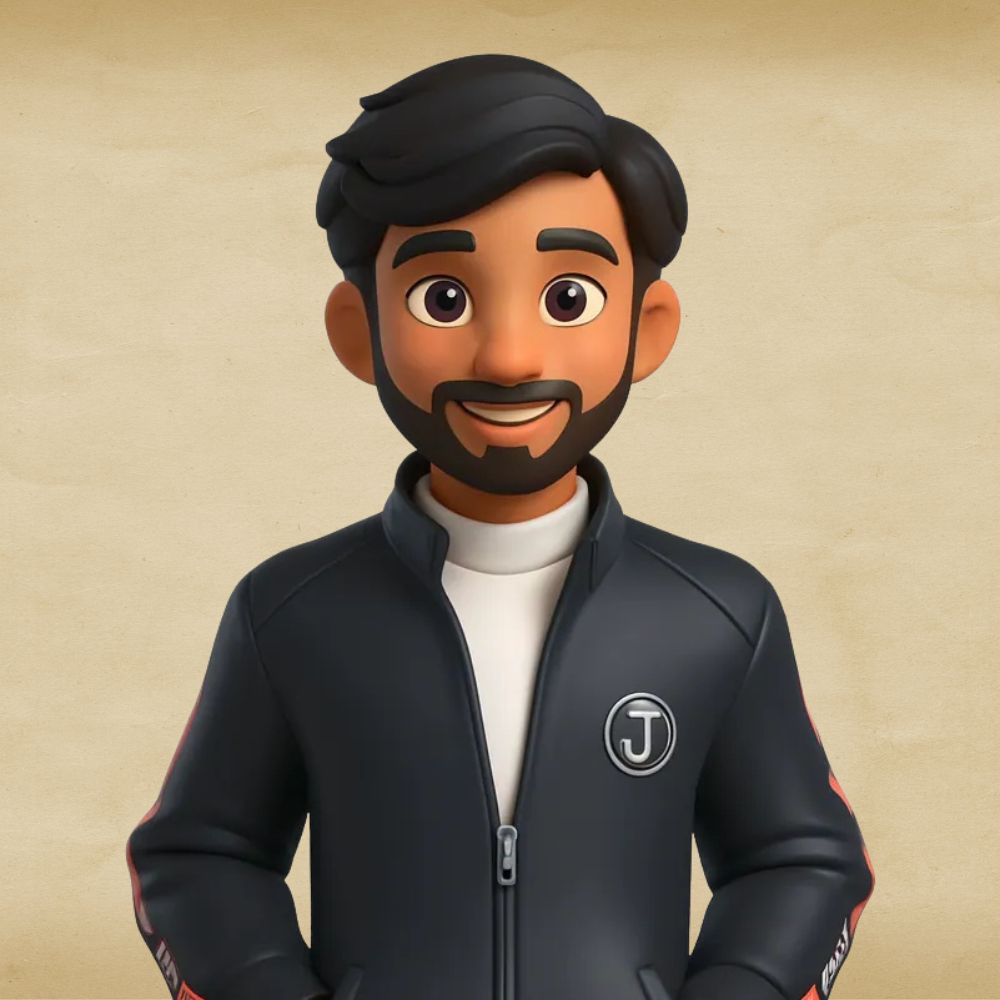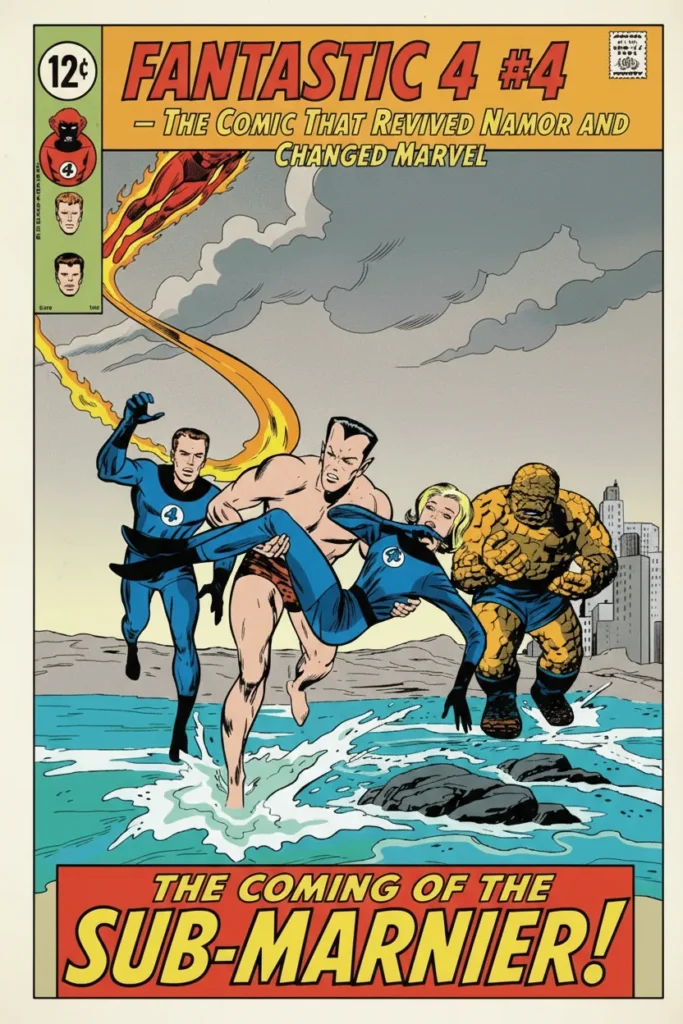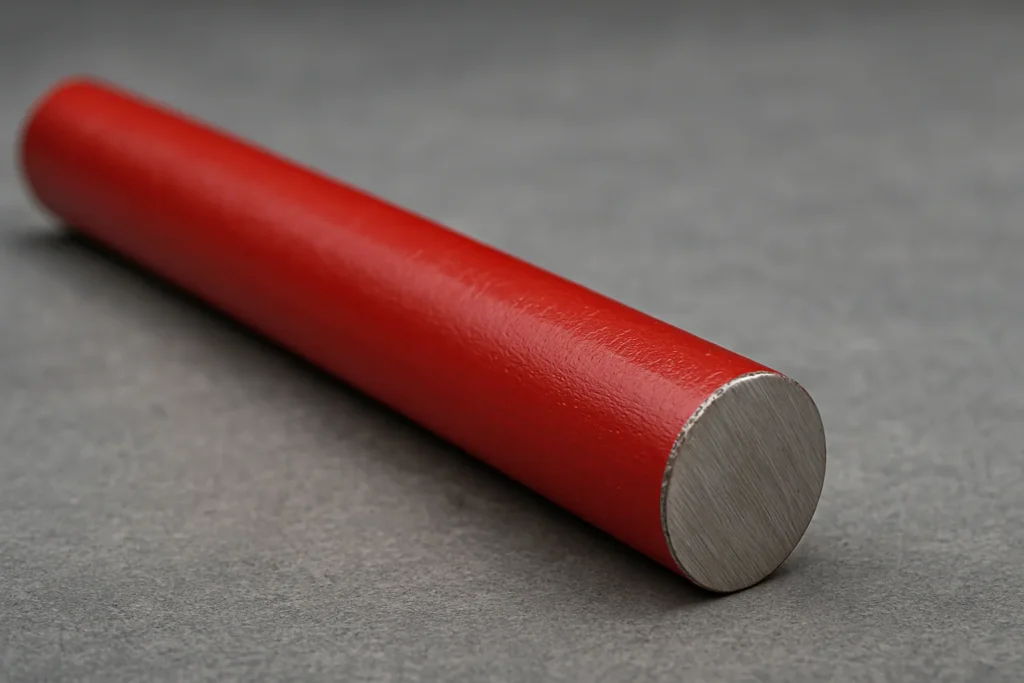You know that feeling when you revisit something old and it suddenly feels new again? That’s exactly what Fantastic 4 #4 gives to every Marvel fan and comic collector. This issue isn’t just a random number in the series — it’s the one where Namor the Sub-Mariner returns after years of absence, reshaping the entire Marvel Universe.
Here’s the thing — if you love the Fantastic Four movies like Fantastic 4 (2005) or Fantastic 4 Rise of the Silver Surfer (2007), you’ll notice how much of their DNA comes straight from this issue. It’s where the family-driven storytelling, wild imagination, and emotional conflict all clicked for the first time.
In this guide, we’ll explore everything from Fantastic 4 #4’s publication history and storyline to its market value, variants, critical reviews, and how it inspired future movies like the upcoming Fantastic 4 (2025). Think of it as a friendly collector’s talk — a mix of facts, nostalgia, and practical insights for anyone curious about one of Marvel’s most influential comics.
Snippet-Ready Definition:
Fantastic 4 #4 (1962) marks Namor’s dramatic comeback and defined Marvel’s storytelling style—mixing human emotion with heroism. It’s a cornerstone issue beloved by fans and collectors alike.
Background & Publication History
Let’s rewind to 1962 — Marvel Comics was still finding its rhythm. Fantastic Four had just debuted a few months earlier, and fans were hooked on this idea of superheroes who actually argued like a real family. Then came issue #4 — written by Stan Lee and drawn by Jack Kirby — and suddenly, history was made.
In Fantastic 4 #4, Marvel re-introduced Namor the Sub-Mariner, one of their earliest heroes from the 1930s. He hadn’t been seen for over a decade, and his comeback turned this issue into a key milestone. For collectors, this makes it part of the “Silver Age Marvel Revival,” where classic Golden Age characters were modernized for a new generation.
The comic was published in May 1962, under Fantastic Four Volume 1, and since then, it’s been reprinted across later runs like Fantastic Four Vol 3, Vol 4 #10 & #16, and Vol 5. Every version pays homage to the creative spark that Lee and Kirby brought — bold lines, dramatic expressions, and a perfect balance between cosmic adventure and human vulnerability.
For fans of the modern series like Fantastic 4 (2018) or those following the new Fantastic 4 (2025) film, this issue acts as a foundation stone. It shows where Marvel’s first family began to truly feel like icons rather than just another superhero team.
Story & Content Overview
So what’s the buzz about? Fantastic 4 #4 opens with the team exploring the city, only to discover a homeless man with amnesia — turns out, that’s Namor the Sub-Mariner. When Johnny Storm (the Human Torch) recognizes him and helps him recover his memory, Namor quickly realizes the Atlanteans are gone, and he vows revenge on the surface world.
It’s such a raw, emotional story. You’ve got Ben Grimm (The Thing) struggling with his monstrous appearance, Reed Richards trying to keep the group together, and Sue Storm (Invisible Woman) torn between empathy and duty. It’s messy, human, and heroic — everything that defines Marvel storytelling today.
Here are a few highlights fans still talk about:
- Namor’s return — a defining Silver Age moment.
- The emotional complexity — not just heroes vs. villains, but moral gray areas.
- Kirby’s art style — bold, cinematic panels that made the action feel alive.
This issue didn’t just tell a story; it built Marvel’s first true universe. Suddenly, older characters like Namor could coexist with new heroes — a shared world that would later evolve into the MCU we know today.
Guess what? Many storylines from Fantastic 4 #4 inspired later film adaptations, especially Fantastic 4 (2005) and Rise of the Silver Surfer (2007). The dynamic of love, loyalty, and conflict within the team all trace back here.
Release Information and Variants
When Fantastic 4 #4 hit stands in May 1962, copies sold for just 12 cents. Hard to imagine, right? Today, those same issues can sell for thousands of dollars. The comic was published under Fantastic Four Vol. 1, and unlike many later issues, it didn’t have flashy variant covers back then. Still, it’s one of the most reprinted issues in Marvel history.
Over the decades, Marvel has re-released it in several collector formats:
- Marvel Masterworks: high-quality hardcover reprints.
- Fantastic Four Omnibus Vol. 1: a must-have for serious fans.
- Digital Editions on Marvel Unlimited: perfect if you just want to read it without hunting down a rare copy.
In later runs like Fantastic Four Vol. 4 #10 and #16 and Vol. 5, Marvel artists have created tributes that echo the spirit of this issue’s cover. Collectors often love connecting those dots — spotting callbacks to the classic 1962 art style.
If you ever see a copy labeled Fantastic Four #4 (Vol 1) in near-mint condition, it’s a treasure. A certified original with clean edges, bright colors, and no spine creases is like holding a piece of comic-book evolution.
Value and Price Guide
Now, let’s talk numbers — because collectors love data almost as much as stories.
As of 2025, a CGC 9.4 graded copy of Fantastic 4 #4 has been known to fetch $80,000 to $100,000 in auctions. Even lower-grade copies (CGC 3.0 – 5.0) can still bring in a few thousand dollars, depending on demand.
Here’s a quick look at what affects the price:
- Condition: spine tears, page color, and cover gloss matter most.
- First appearance significance: Namor’s comeback drives up value.
- Cultural trends: Every time a Fantastic Four movie or MCU hint drops, prices spike.
- Certification: CGC or CBCS-graded books sell for up to 3× more than raw copies.
If you’re new to comic investing, here’s a tip — track sites like GoCollect or Key Collector Comics to monitor prices. Don’t jump into a bidding war unless you’ve compared grades. And remember, Fantastic 4 #4 is one of those comics that tends to hold steady value no matter what the market does. It’s like the blue-chip stock of Marvel comics.
For reprint collectors, there are affordable ways to own this piece of history too — Marvel Masterworks Vol 1, Epic Collections, or even Fantastic Four Vol 5 issues that revisit its storyline.
Critical Reception and Reviews
Here’s the thing — when Fantastic 4 #4 first released, the comic world didn’t yet realize it was witnessing a turning point. Reviews from the early 60s were simple fan letters praising Stan Lee’s writing and Kirby’s dynamic art. But as time went on, critics started calling it one of the most important Silver Age Marvel issues ever made.
Modern reviewers from outlets like CBR, IGN, and Screen Rant have celebrated it for:
- Introducing emotional realism in superhero storytelling.
- Reviving a forgotten Golden Age icon (Namor) and blending him into the modern Marvel world.
- Laying groundwork for shared-universe storytelling that later defined the MCU.
Fans today still rate Fantastic 4 #4 as a top-tier collectible. On Goodreads and comic forums, it often earns 4.5+ stars. Collectors admire how it manages to be both classic and surprisingly modern — you can feel the tension, humor, and teamwork that later movies tried to capture.
On top of that, many critics note that this issue gave readers their first real taste of Marvel’s storytelling formula — flawed heroes who argue, make mistakes, and still come through for each other. That emotional realism became Marvel’s secret weapon.
Artwork, Artists & Cover Analysis
The art in Fantastic 4 #4 is where you really see Marvel’s magic starting to take shape. Jack Kirby was at his creative peak here, and his style gave the story its pulse. The way he used motion lines, bold shadows, and facial expressions made every scene feel alive. You can sense the tension when The Thing flexes or when Namor rises from the ocean — all without a single extra word.
The color palette by Stan Goldberg was simple yet striking — deep ocean blues, fiery reds, and pale yellows that gave the panels energy and emotion. Even by today’s standards, the page composition feels cinematic.
As later volumes — Fantastic Four Vol 3, Vol 4, and Vol 5 — came out, the art evolved with the times. Modern editions brought sharper lines and digital shading, but the DNA of Kirby’s design stayed the same. Every artist since has borrowed from his signature traits: strong outlines, dynamic poses, and that “larger-than-life” energy that made Fantastic 4 #4 a timeless collectible.
The cover symbolism is unforgettable too. Namor standing tall against crashing waves shows more than power — it’s rebirth and revenge rolled into one. It marks Marvel’s shift from simple heroics to deeper storytelling about identity and consequence.
Role in the Fantastic Four Franchise and the MCU
If you’ve watched any Fantastic Four film, you’ve already seen echoes of Fantastic 4 #4. The emotional beats between Reed Richards, Sue Storm, Johnny Storm, and Ben Grimm all originate here.
The 2005 movie starring Jessica Alba and Ioan Gruffudd used similar dynamics — love triangles, team tension, and Namor-style arrogance in Doctor Doom. Then Fantastic 4 (2015) tried to modernize the same themes with a darker tone. And now, with Fantastic 4 (2025) confirmed by Marvel Studios, the rumor mill is buzzing again — will Namor appear? Will the movie reference his 1962 comeback?
It’s safe to say this issue shaped not just the comics but the films themselves. The upcoming MCU version will likely borrow emotional cues from Fantastic 4 #4 — family over fame, power versus responsibility, and the idea that even heroes struggle with identity.
And let’s not forget The Thing. His character growth in this issue, torn between humanity and his rocky form, became one of Marvel’s most relatable storylines. Every modern portrayal — from Michael Chiklis’s take in 2005 to Jamie Bell’s in 2015 — owes something to the soul of Fantastic 4 #4.
Cast, Characters, and Team Dynamics
At its core, this issue wasn’t just about superpowers — it was about people.
The Fantastic Four were the first heroes to argue like a real family, and that made readers feel something deeper.
Here’s a quick character rundown:
- Reed Richards (Mr. Fantastic): the thinker who sometimes lets logic override heart.
- Sue Storm (Invisible Woman): the moral anchor balancing empathy and duty.
- Johnny Storm (Human Torch): fiery in more ways than one — brave, reckless, and loyal.
- Ben Grimm (The Thing): the emotional core, forever caught between heroism and heartbreak.
And of course, Namor the Sub-Mariner. His return created tension like never before — especially with Sue, whose compassion for him hinted at a subtle emotional triangle. It was storytelling gold, and fans still debate those pages decades later.
The way Lee and Kirby wrote their conversations was revolutionary. Instead of perfect heroes, they gave us people who loved, fought, and doubted — making them feel real. That’s why even today’s readers, after watching the high-tech Fantastic 4 movies, can go back to this comic and still connect emotionally.
Comparisons with Other Issues & Volumes
When you compare Fantastic 4 #4 with later issues like Fantastic Four Vol 4 #10 or Vol 4 #16, you can see how far the series came — and how much started here. The newer volumes have refined dialogue and cinematic pacing, but #4 carries that raw emotional punch that only early comics had.
Fantastic 4 (2018), for example, looks sleeker and reads smoother, yet the heart is the same: family bonds tested by impossible adventures. It’s clear that every reboot — from Vol 3 to Vol 5 — is just expanding on the tone and energy born in issue #4.
In short, #4 stands out because it’s where Marvel first mixed human emotion with superhero spectacle. It connected past and future, bridging the Golden Age with the modern MCU era — and that’s why collectors still treat it as the crown jewel of Fantastic Four history.
Cultural Significance and Fan Impact
Ask any long-time Marvel reader what makes Fantastic 4 #4 special, and you’ll probably see a smile first. This single comic transformed the Fantastic Four from just another superhero team into cultural icons. It re-introduced Namor, created emotional tension that still echoes through the franchise, and proved that comics could tell stories that were about people just as much as powers.
The issue also shaped how fans viewed the team dynamic. Before this, most superhero teams were perfect and polite. But here, readers saw arguments, humor, and moments of doubt — things that felt real. That human edge inspired everything from The Avengers to X-Men.
In Latin America, fans knew the group as Los 4 Fantasticos, and even decades later, Spanish editions of Fantastic 4 #4 are collector favorites. The issue’s legacy has spread across languages, cultures, and generations — proving that good storytelling never ages.
Comparison Table: Fantastic 4 #4 vs Modern Volumes
| Feature | Fantastic 4 #4 (1962) | Fantastic Four Vol 4 & 5 (Modern) |
| Art Style | Hand-drawn Jack Kirby dynamism, bold lines, vintage colors | Digital art, refined shading, cinematic layouts |
| Storytelling | Simple yet emotional, focused on Namor’s return | Complex plots, deeper science and character arcs |
| Themes | Family, identity, redemption | Legacy, evolution, modern morality |
| Collectibility | Highly valuable Silver Age issue | Moderate collector interest, easier availability |
| Cultural Impact | Birth of Marvel’s shared universe | Continuation and modernization of the same legacy |
Quick Bullet Guide: How to Identify an Authentic Copy
- Check the publication date: May 1962, labeled Fantastic Four Vol. 1 #4.
- Inspect the cover: Namor emerging from the sea; bright blue and yellow tones.
- Look for 12-cent price tag: Original editions feature this marker.
- Examine paper quality: Slightly tan pages but no glossy finish.
- Verify certification: Prefer CGC or CBCS-graded versions for resale value.
Common Questions and Myths
Every famous comic brings its share of mysteries, and Fantastic 4 #4 is no exception.
Is it rare?
Yes, but not impossible to find. Because it’s a Silver Age issue from 1962, most surviving copies are in lower grades. High-grade certified ones are much rarer and highly sought after.
What’s its current value?
Prices change with market trends, especially when Marvel announces new projects. When rumors about Fantastic 4 (2025) or Namor’s MCU role surface, auction sites light up.
How long is the issue?
It’s the standard 22-page comic of its era — short, punchy, and packed with emotion.
How many post-credit scenes are in the new Fantastic 4 movie?
We’ll have to wait and see, but if history repeats itself, you can bet there’ll be a tease linked to this comic’s legacy.
And here’s a fun myth: Some collectors once believed Fantastic 4 #4 was Namor’s first appearance. In truth, his debut was way back in Marvel Comics #1 (1939). This issue just brought him back — older, bolder, and more complex.
Expert Tips for Collectors and Enthusiasts
If you’re thinking about collecting Fantastic 4 #4, here are a few friendly tips that come from years of experience flipping through long boxes and auction catalogs.
- Authenticate before you celebrate. Always buy graded copies from trusted sources. Check for CGC or CBCS certification to avoid counterfeits.
- Preserve it properly. Store your comic in a Mylar bag with acid-free backing. Keep it in a cool, dry place away from sunlight.
- Track the market. Watch how announcements about Fantastic 4 (2025) affect pricing. Historically, values spike right before a movie release.
- Join communities. Reddit’s r/comicbooks and the CGC Boards are great for networking with fellow collectors and getting real-time pricing insights.
And if you can’t afford an original, don’t worry — Marvel Masterworks Vol. 1, Fantastic Four Omnibus, and Epic Collections give you the same thrill for a fraction of the price.
Related Issues and Reading Guide
If Fantastic 4 #4 hooked you, there’s plenty more to explore.
Start with:
- Fantastic Four #1–#3: to understand how the team formed.
- Fantastic Four #5: the first appearance of Doctor Doom.
- Fantastic Four Vol 4 #10 and #16: modern arcs that echo Namor’s rivalry and the team’s evolving chemistry.
- Fantastic 4 (2018): a fresh reboot that honors the original spirit.
Each of these issues adds another layer to what makes Marvel’s first family so enduring.
Glossary for New Comic Readers
If you’re new to comic collecting, a few quick terms will help:
- Variant cover: alternate artwork released for the same story.
- First print: the original release; later prints are re-issues.
- CGC grading: professional evaluation on a 1–10 scale that impacts value.
- Volume numbering: every major reboot or era is marked as a new volume.
Understanding these basics makes collecting Fantastic 4 #4 feel less intimidating and a lot more fun.
Future of the Fantastic Four
The future’s looking bright — and cinematic. Fantastic 4 (2025) is shaping up to re-introduce Marvel’s first family to a whole new generation. With Marvel Studios confirming the project as part of Phase 6, fans are buzzing about casting news and story direction.
Will the movie revisit Namor’s connection to Sue Storm? Will it mirror the family tension from the 1962 issue? Many believe it will — and if it does, Fantastic 4 #4 will once again prove why it’s timeless.
Beyond films, Marvel Comics continues to explore new volumes like Fantastic Four Vol 5, keeping the same mix of science, adventure, and emotion that defined this series from day one.
Conclusion
So here’s the takeaway — Fantastic 4 #4 isn’t just another old comic; it’s a piece of living history. It taught Marvel how to blend heart with heroism and set the tone for everything from Spider-Man to The Avengers.
The best part is, even six decades later, it still feels fresh. You can open those pages and feel the same excitement readers felt in 1962 — the thrill of discovery, the tension of conflict, the hope of heroes finding their way.
If you ever get the chance to hold a copy, even a reprint, take a moment. You’re not just touching paper and ink — you’re holding the spark that lit the Marvel Universe. And that, my friend, is truly fantastic.
Disclaimer
This article is for informational and educational purposes only. Prices, release details, and opinions mentioned are based on publicly available sources and may change over time. We don’t sell or appraise collectibles—always consult certified dealers or grading services before buying or selling Fantastic 4 #4 comics.

Hi, I’m Bilal, the founder of outofmagazine.com. I love sharing fresh ideas, stories, and helpful insights on all kinds of topics that spark curiosity. My goal with this site is simple—to create a space where readers can find inspiration, useful tips, and engaging reads on lifestyle, trends, and everything in between.



